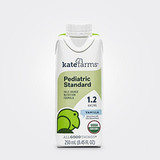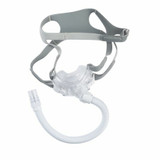
The Caregiver Guide - Weatherproofing Against Flu
Influenza, more commonly known as the flu, is a highly contagious respiratory illness that has a significant impact on many affected individuals and society as a whole. The illness is caused by a virus, and symptoms can range from mild to severe, with fever, coughing, sore throat, muscle aches and fatigue being the most common. Because a large proportion of cases experience only mild symptoms and only for a couple of days, people tend to underestimate how serious a health condition it actually is.
We have extracted some facts and figures about the flu virus from the In-Season Burden Estimates published by the Centers for Disease Control and Prevention (CDC) . This report is updated regularly throughout the year, with the current version covering the period is October 1st, 2023, to June 15th, 2024 – a period of less than nine months:
- Number of illnesses: 35 to 65 million
- Number of medical visits: 16 to 30 million
- Number of hospitalizations: 390,000 to 830,000
- Number of deaths: 25,000 to 72,000
The economic impact of influenza is also substantial. A National Institutes of Health (NIH) report puts the total cost in the US at $11.2 billion annually. In this article, we will discuss types of flu, their symptoms and risks and, more importantly, what you can do to safeguard yourself and those in your care from the flu or, at least, mitigate the risk of falling victim to it.
What is Flu?
Although the word is most commonly associated with winter, it is, in fact, an all-season illness. It’s triggered by the highly contagious Influenza A and B viruses. These viruses circulate all year round, but they’re much more aggressive during the fall and winter months (October to May). For this reason, the cold months are known as “flu season”, and the illness is commonly called “seasonal flu.”
Summer flu, on the other hand, is slightly different. While you can contract Influenza A or B during the hotter months, it is not very common. What we refer to as summer flu is actually caused by a different set of viruses, including enteroviruses, adenoviruses and the respiratory syncytial virus (RSV). These viruses are more prevalent in the warmer months, and they’re also extremely contagious.
Symptoms
The symptoms of seasonal and summer flu are very similar. All of the underlying viruses infect the lungs and the respiratory tract. Incubation periods differ slightly, with seasonal flu being between one and four days and the summer flu viruses generally varying from two to eight days. Symptoms typically include one or more of the following:
- Fever or chills
- Cough (dry or productive)
- Sore throat
- Runny or stuffy nose
- Muscle aches and body aches
- Headache
- Fatigue
- Nausea, vomiting and diarrhea may occur in some cases, but mostly in children
In the majority of cases, the flu symptoms will clear up by themselves within three days to a week, although coughing and a general run-down feeling may persist for a while longer. Where there are complications or comorbidities, the flu may be a catalyst for something far more serious.
Underlying Medical Risks
Although most people recover from the flu within a week or two, the virus can pose a serious risk of potentially life-threatening complications. Adults over the age of 65 and young children are particularly vulnerable. Here are some of the most common risks:
Secondary Bacterial Infections
Influenza viruses primarily attack the respiratory system, damaging the lining of the nose, throat, and lungs. This weakens the body's natural defenses, making it more susceptible to secondary bacterial infections, such as:
- Pneumonia: The most serious complication of influenza, it causes inflammation of the lung tissue and can lead to breathing difficulties, low oxygen levels, and even death.
- Bronchitis: Inflammation of the airways in the lungs, causing coughing, wheezing, and chest tightness.
- Sinusitis: Inflammation of the sinuses, leading to facial pain, congestion, and headache.
Aggravation of Chronic Health Conditions
The flu virus puts a strain on the body's immune system as it fights off the infection, hindering the body's ability to manage existing chronic conditions effectively.
- Heart Disease: There may be an increased risk of heart attack, stroke, and heart failure.
- Chronic Obstructive Pulmonary Disease (COPD): COPD symptoms like shortness of breath and wheezing can be compounded.
- Asthma: The flu can trigger asthma attacks, which can, in rare cases, be fatal.
- Diabetes: Increased blood sugar levels can contribute to nerve damage, kidney disease and various other long-term health conditions.
Increased Risk of Other Complications
- Myocarditis: Inflammation of the heart muscle.
- Pericarditis: Inflammation of the sac surrounding the heart.
- Encephalitis: Inflammation of the brain.
Prevention and Treatment
Vaccination: The most effective defense against seasonal flu is vaccination. CDC figures suggest a 40 to 60% reduction in the risk of getting the flu if the vaccine matches the circulating flu virus. For those who do fall ill, vaccines usually reduce the severity of symptoms and the risk of more serious issues. Lower infection rates also contribute to herd immunity.
Medications: Antiviral medications can reduce the risk of getting ill for vulnerable groups like the elderly, pregnant women or people with chronic conditions. They may also shorten the duration of the illness or reduce its severity if taken within two days of becoming infected.
Contain the virus: Containment measures like vaccination, good hygiene practices and social distancing can significantly reduce the number of people who get infected. This is particularly important to safeguard vulnerable groups or those in high-risk settings like nursing homes, daycare centers, and hospitals.
Conclusion
You have a one-in-twelve chance of getting the flu in the next 12 months. This is according to a report published in the Clinical Infectious Diseases journal. We hope that this article has given you a better understanding of the causes and symptoms of the illness and that you’re also better equipped to deal with it when it does get through your defenses. Before we sign off, though, here’s something we haven’t discussed yet.
A healthy diet can boost your immune system and help you avoid infection. If you’re not sure you’re getting all the nutrients your body needs, contact us at LL Medico. We stock a comprehensive range of quality nutritional supplements to optimize your nutrition and keep you fit and strong. If you’re unfortunate enough to fall ill, we have a selection of respiratory care items and vitamins and minerals to help you manage the symptoms. Contact us at (855) 422-4556 or email [email protected] today; we’ll be at your side throughout this fight.



































































































































